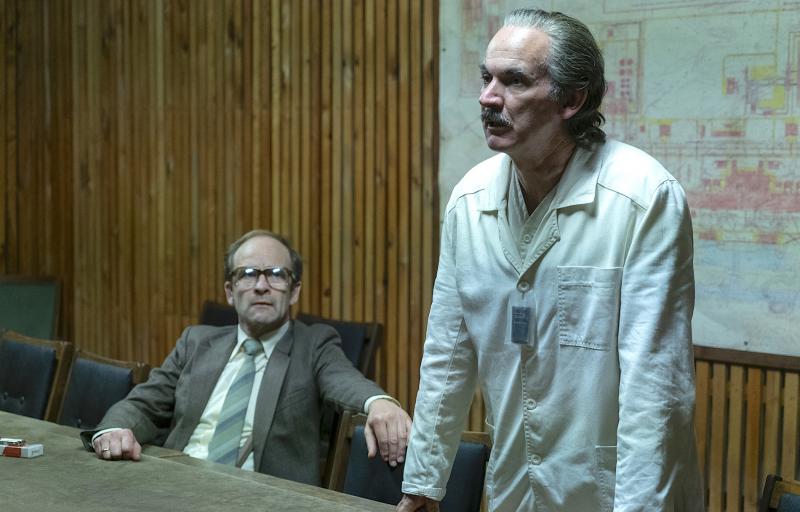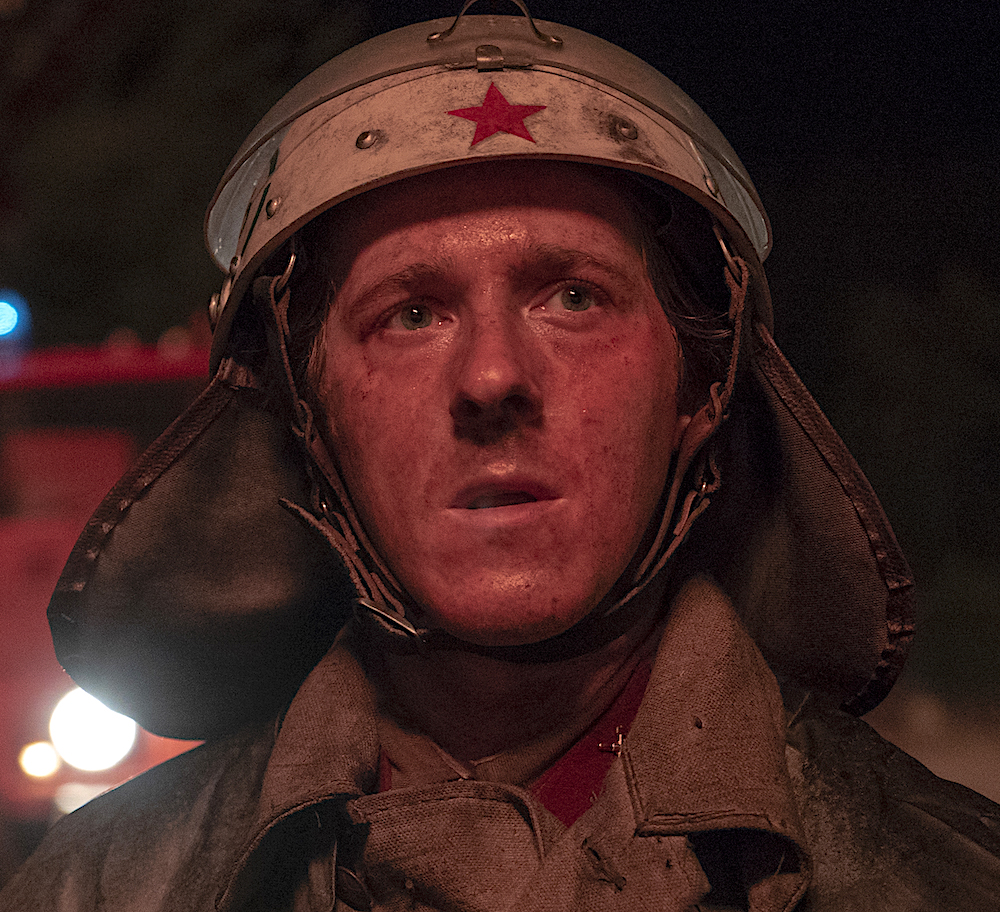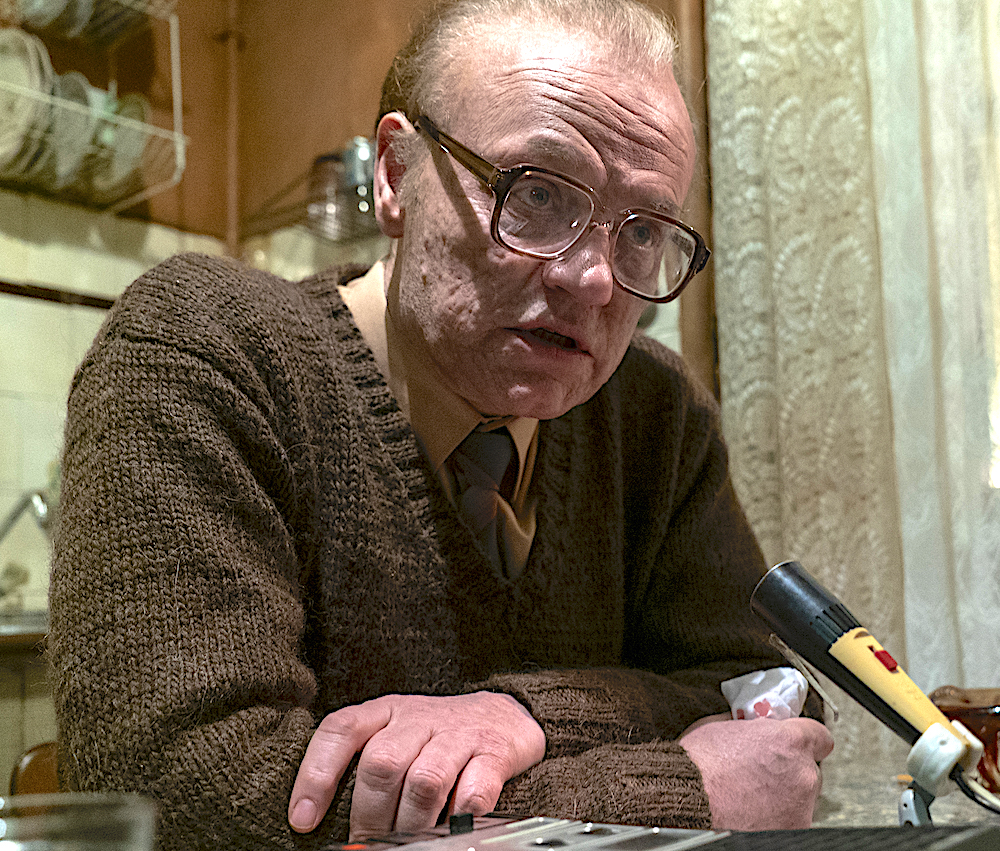Chernobyl, Sky Atlantic review - a glimpse of Armageddon | reviews, news & interviews
Chernobyl, Sky Atlantic review - a glimpse of Armageddon
Chernobyl, Sky Atlantic review - a glimpse of Armageddon
A real-life disaster movie you can't tear yourself away from

“I take it the safety test was a failure,” remarked Viktor Bryukhanov, director of Ukraine’s Chernobyl nuclear power station. You could say that again.
A five-part drama series about Chernobyl might sound like a recipe for unalloyed misery, yet thanks to a gripping screenplay from Craig Mazin and punchy direction by Johan Renck, this HBO/Sky production proved fatally addictive as it rushed us into the molten core of the story. It was like a nightmare unfolding, as (at first through the eyes of Jessie Buckley’s Lyudmilla Ignatenko) we saw the flash of distant eruptions, before the full terror of the situation unravelled from a fog of chaos and ignorance. A strange, laser-like blue light shone up from the plant into the sky, luring local families out to watch like sightseers at a fireworks display, unaware that the particles floating down on them in ominous slow-motion carried lethal contamination. Lyudmilla’s firefighter-husband Vasily became one of the first fatalities, condemned to a hideous death from radiation poisoning (Adam Nagaitis, pictured below).
 The careful accretion of detail gradually pieced together a toxic jigsaw from hell. At first, nobody could grasp the seemingly impossible fact that the reactor core had exploded, showering the area with lumps of lethal, smouldering graphite. Deputy chief engineer Anatoly Dyatlov (Paul Ritter) – “an arrogant, unpleasant man”, according to scientist Valery Legasov, compellingly played by Jared Harris (pictured below) as the moral conscience of the story – coldly barked out orders to his panicking staff, who were oddly reminiscent of bakers in their white smocks and caps.
The careful accretion of detail gradually pieced together a toxic jigsaw from hell. At first, nobody could grasp the seemingly impossible fact that the reactor core had exploded, showering the area with lumps of lethal, smouldering graphite. Deputy chief engineer Anatoly Dyatlov (Paul Ritter) – “an arrogant, unpleasant man”, according to scientist Valery Legasov, compellingly played by Jared Harris (pictured below) as the moral conscience of the story – coldly barked out orders to his panicking staff, who were oddly reminiscent of bakers in their white smocks and caps.
Dyatlov remained unmoved by the sight of vomiting, blood-drenched casualties, and hailed the radiation-meter readings of 3.6 roentgen as nothing to get alarmed about. However, it transpired that 3.6 was the highest figure the meters could display. The real figure was 30,000 roentgen. When the luckless Anatoly Sitnikov (Jamie Sives) was ordered to climb up on the roof and look down on the destroyed reactor, the dosage immediately began to turn his flesh a dark crimson.
 This was back in the old USSR, and the drabness of Soviet life was vividly captured in barracks-like buildings, sludge-coloured furnishings and clothes which were the antidote to fashion. The nearby town of Pripyat, now uninhabited, resembled a grim battery farm for workers and their families, a socialist-realist cul-de-sac. Adding blood-freezing authenticity is the fact that the series was shot at the disused Ignalina nuclear power station in Lithuania, of very similar design to Chernobyl. Instinctively, paranoid officialdom smothered the disaster in lies and misinformation. “The accident is well under control,” insisted Byurkhanov (Con O’Neill), and phone lines from Chernobyl were cut to seal off the bad news and “to keep the people from undermining the fruits of their own labour”, as the diehard old party official Zharkov (Donald Sumpter) put it.
This was back in the old USSR, and the drabness of Soviet life was vividly captured in barracks-like buildings, sludge-coloured furnishings and clothes which were the antidote to fashion. The nearby town of Pripyat, now uninhabited, resembled a grim battery farm for workers and their families, a socialist-realist cul-de-sac. Adding blood-freezing authenticity is the fact that the series was shot at the disused Ignalina nuclear power station in Lithuania, of very similar design to Chernobyl. Instinctively, paranoid officialdom smothered the disaster in lies and misinformation. “The accident is well under control,” insisted Byurkhanov (Con O’Neill), and phone lines from Chernobyl were cut to seal off the bad news and “to keep the people from undermining the fruits of their own labour”, as the diehard old party official Zharkov (Donald Sumpter) put it.
It’s a story of heroism as well as horror, as soldiers, workers and helicopter pilots make suicidal sacrifices to contain the damage. Chernobyl changes gear in episode two, as scientists Legasov and Ulana Khomyuk (Emily Watson) and government bigwig Boris Shcherbina (in a commanding turn by Stellan Skarsgård) step to the fore. It’s a real-life disaster movie that you can’t tear yourself away from.
The future of Arts Journalism
You can stop theartsdesk.com closing!
We urgently need financing to survive. Our fundraising drive has thus far raised £49,000 but we need to reach £100,000 or we will be forced to close. Please contribute here: https://gofund.me/c3f6033d
And if you can forward this information to anyone who might assist, we’d be grateful.

Subscribe to theartsdesk.com
Thank you for continuing to read our work on theartsdesk.com. For unlimited access to every article in its entirety, including our archive of more than 15,000 pieces, we're asking for £5 per month or £40 per year. We feel it's a very good deal, and hope you do too.
To take a subscription now simply click here.
And if you're looking for that extra gift for a friend or family member, why not treat them to a theartsdesk.com gift subscription?
more TV
 The Perfect Neighbor, Netflix review - Florida found-footage documentary is a harrowing watch
Sundance winner chronicles a death that should have been prevented
The Perfect Neighbor, Netflix review - Florida found-footage documentary is a harrowing watch
Sundance winner chronicles a death that should have been prevented
 Murder Before Evensong, Acorn TV review - death comes to the picturesque village of Champton
The Rev Richard Coles's sleuthing cleric hits the screen
Murder Before Evensong, Acorn TV review - death comes to the picturesque village of Champton
The Rev Richard Coles's sleuthing cleric hits the screen
 Black Rabbit, Netflix review - grime and punishment in New York City
Jude Law and Jason Bateman tread the thin line between love and hate
Black Rabbit, Netflix review - grime and punishment in New York City
Jude Law and Jason Bateman tread the thin line between love and hate
 The Hack, ITV review - plodding anatomy of twin UK scandals
Jack Thorne's skill can't disguise the bagginess of his double-headed material
The Hack, ITV review - plodding anatomy of twin UK scandals
Jack Thorne's skill can't disguise the bagginess of his double-headed material
 Slow Horses, Series 5, Apple TV+ review - terror, trauma and impeccable comic timing
Jackson Lamb's band of MI5 misfits continues to fascinate and amuse
Slow Horses, Series 5, Apple TV+ review - terror, trauma and impeccable comic timing
Jackson Lamb's band of MI5 misfits continues to fascinate and amuse
 Coldwater, ITV1 review - horror and black comedy in the Highlands
Superb cast lights up David Ireland's cunning thriller
Coldwater, ITV1 review - horror and black comedy in the Highlands
Superb cast lights up David Ireland's cunning thriller
 Blu-ray: The Sweeney - Series One
Influential and entertaining 1970s police drama, handsomely restored
Blu-ray: The Sweeney - Series One
Influential and entertaining 1970s police drama, handsomely restored
 I Fought the Law, ITVX review - how an 800-year-old law was challenged and changed
Sheridan Smith's raw performance dominates ITV's new docudrama about injustice
I Fought the Law, ITVX review - how an 800-year-old law was challenged and changed
Sheridan Smith's raw performance dominates ITV's new docudrama about injustice
 The Paper, Sky Max review - a spinoff of the US Office worth waiting 20 years for
Perfectly judged recycling of the original's key elements, with a star turn at its heart
The Paper, Sky Max review - a spinoff of the US Office worth waiting 20 years for
Perfectly judged recycling of the original's key elements, with a star turn at its heart
 The Guest, BBC One review - be careful what you wish for
A terrific Eve Myles stars in addictive Welsh mystery
The Guest, BBC One review - be careful what you wish for
A terrific Eve Myles stars in addictive Welsh mystery
 theartsdesk Q&A: Suranne Jones on 'Hostage', power pants and politics
The star and producer talks about taking on the role of Prime Minister, wearing high heels and living in the public eye
theartsdesk Q&A: Suranne Jones on 'Hostage', power pants and politics
The star and producer talks about taking on the role of Prime Minister, wearing high heels and living in the public eye
 King & Conqueror, BBC One review - not many kicks in 1066
Turgid medieval drama leaves viewers in the dark
King & Conqueror, BBC One review - not many kicks in 1066
Turgid medieval drama leaves viewers in the dark

Add comment